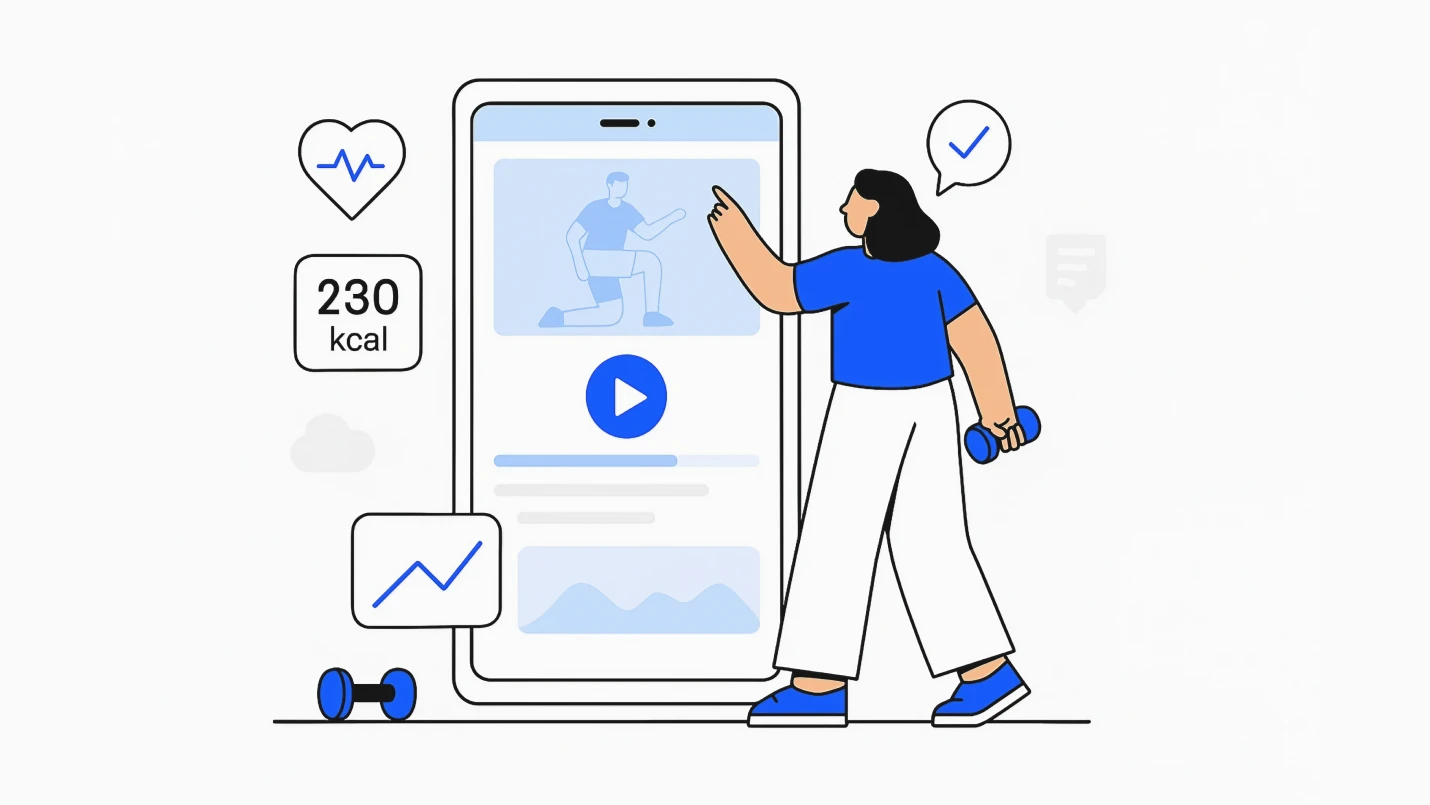The fitness industry has grown year after year, and it’s currently valued at $32 billion USD. What’s strange is that, at the same time, personal weight has also skyrocketed—with worldwide obesity rates tripling since 1975.
Are we working out more to compensate for all those McDonald’s meals we consume? Or is the world dividing itself between the fit and the husky?
Whatever the case, the fitness market shows no signs of slowing. And with gyms gradually re-opening in a post-Covid-vaccine world, the market for workout apps and fitness apps (currently worth around US $4.4 billion) is poised for growth.
Are you thinking about launching your own fitness app? If so, then take some time to study the 10 best fitness apps on the market today. Learn from their features, their UX design, and how they help their users attain slimmer, stronger, healthier bodies.
Do you already have an idea for a fitness app you think shows promise? Set up a free consultation with one of our specialists here at Net Solutions, and we’ll help you explore your options.

We respect your privacy. Your information is safe.
1. MyFitnessPal
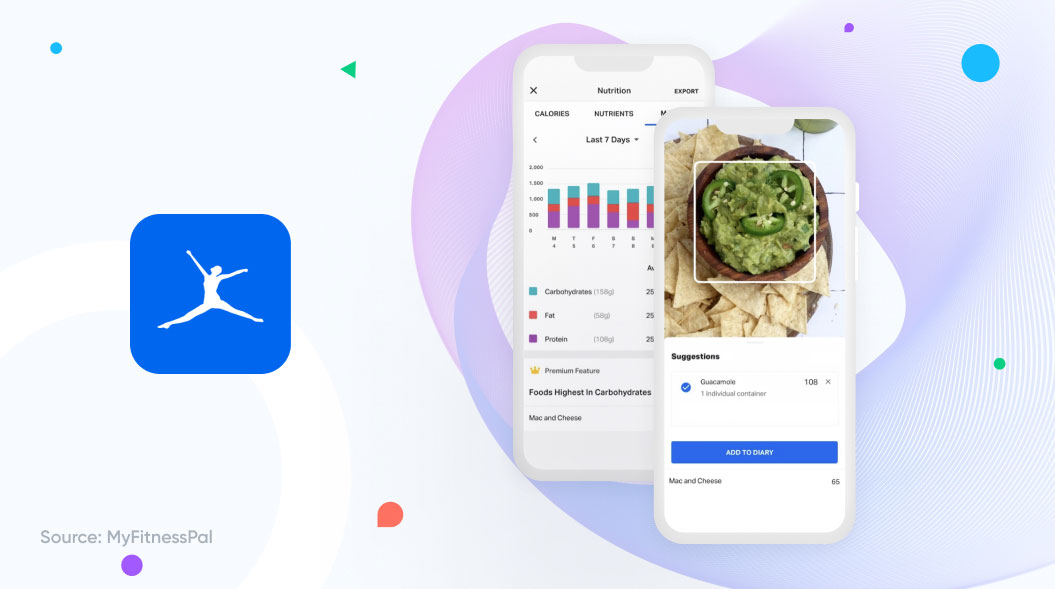
Launched all the way back in 2005, MyFitnessPal is the O.G. of calorie-counting apps. Based on the simple principle of calories-in-calories-out, this app gives users a straightforward set of tools to track their daily intake of calories and nutrients alongside the calories they expend (by living, breathing, and working out).
MyFitnessPal users can search the platform’s vast database of foods to catalog each meal. If a food isn’t already in the database (which is rare), they can enter the information manually. Users can also scan the barcode label on prepared foods, and if the brand is in the database, it will automatically populate the appropriate fields. All the user needs to do is update their serving size.
What made MyFitnessPal successful?
- Exceptional food database that experts have studied and found to be quite accurate
- Seamless integrations with other apps and devices (e.g., Apple Watch, Fitbit)
- Online message boards where people can connect with others on a similar fitness journey, share their fitness data with friends for accountability, and build community
2. Planet Fitness Workouts
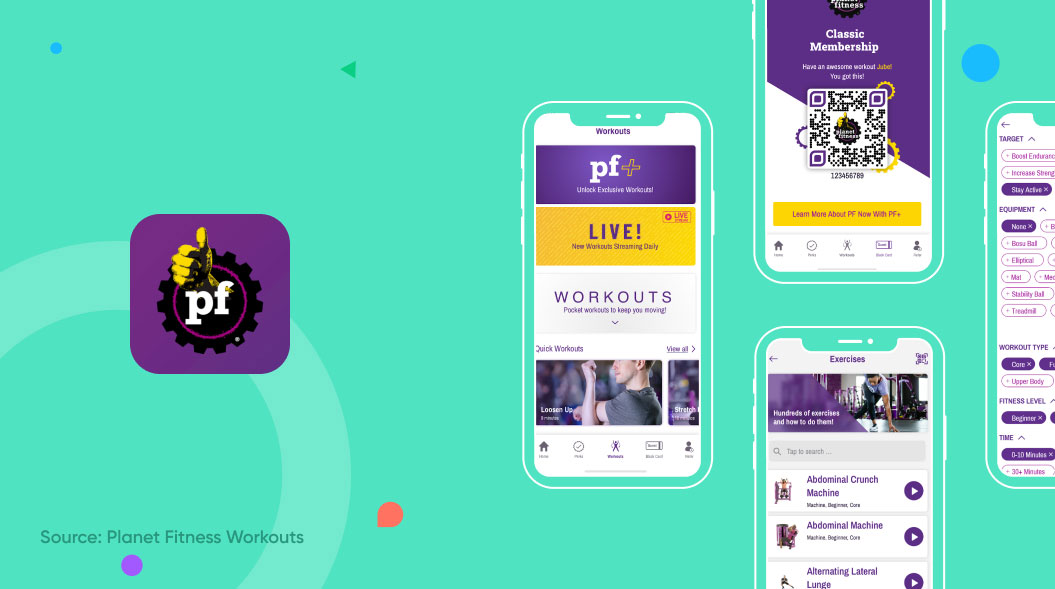
Planet Fitness offers one of the best free fitness apps available. It’s free because it’s essentially a marketing tool for Planet Fitness, one of the largest gyms chains in North America with over 2000 locations across the United States (plus a smattering of sites in Canada and Mexico).
Designed to compete against 24-Hour Fitness and other reasonably priced gym chains, Planet Fitness offers tremendous value. They also did well at the height of the Covid-19 pandemic by taking a proactive approach to creating a safe environment—requiring masks, moving cardio machines apart more than 6 feet (2 meters), strictly enforcing cleaning, and more. They also launched a work-out-at-home program, where people could attend classes online, keeping them engaged during lockdowns.
The app itself is great for tracking workouts, and it offers a host of benefits for Planet Fitness members, such as a tracker to tell members when their local gym is busy and when it’s a good time to workout. This not only keeps members engaged and coming back, but it also helps the club operate at an ideal capacity so the company can maximize resources.
What made the Planet Fitness App successful?
- Progress tracker to encourage regular exercise
- Pre-recorded guidance from trainers on cardio and weight lifting
- Crowd Meter to tip users off when the gym is at low capacity
3. Apple Fitness+
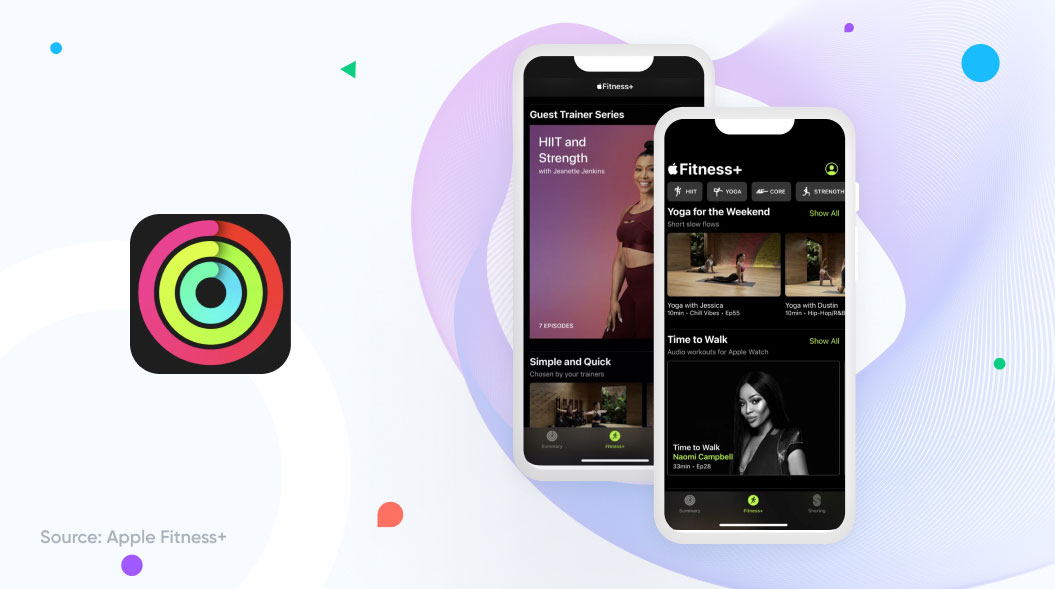
Apple Fitness+ is the paid fitness app that comes free for the first 3 months after you purchase an Apple Watch. The obvious benefit to Apple Fitness+ is that it’s one of the best Apple Watch Fitness apps, since it was specifically designed for the device. As you can imagine, Apple Fitness+ integrates seamlessly with the Apple Watch to track your heart rate, steps, and other vitals.
Apple Fitness+ plus also includes a wide range of guidance on different workout routines, including Pilates, Strength training, and Yoga. It also offers new workouts each week, along with guided meditation sessions. After all, a healthy mind is tied to a healthy body.
What made Apple Fitness+ successful?
- The app fits perfectly with the Apple ecosystem, including its wearable Apple Watch
- Powerful training videos users can stream from any Apple device
- The clean, uncluttered UX we’ve come to expect from Apple
Download: iOS
4. Jefit
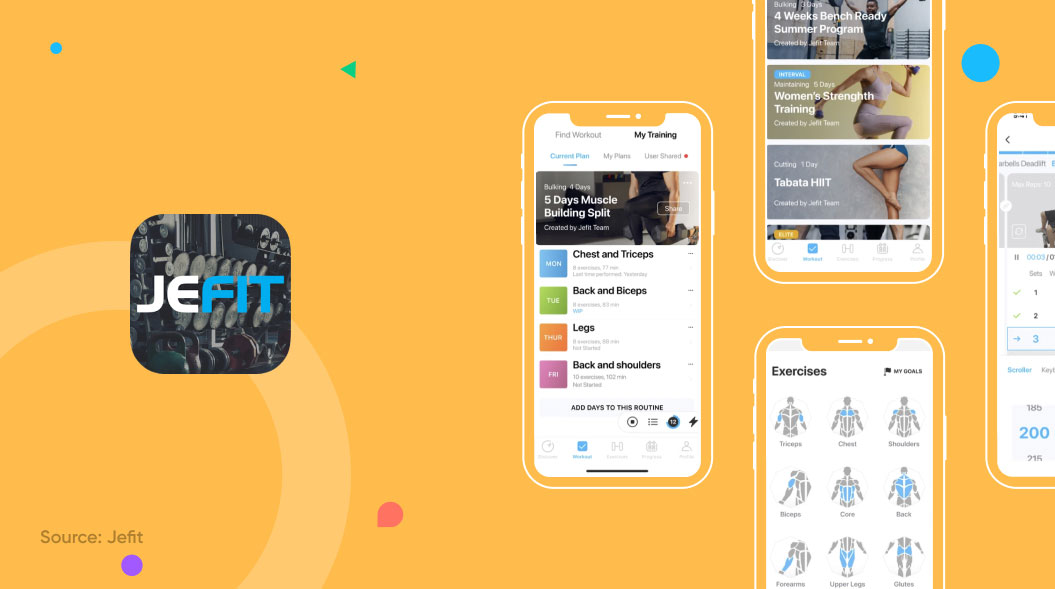
Jefit is a favorite workout app for people focused on weight lifting (what’s commonly called resistance training among experts). The app allows users to track all kinds of workouts, including cardio training, but it does the weight lifting component exceptionally well.
Users who want a full-body workout can search the app for exercises based on the major muscle group they build. When they do that, all the relevant exercises pop up. Users can then learn proper form for plenty of strength-training exercises. This is true whether they have access to a gym with machines that have fancy names (like “thigh abductor” or “seated leg curl”), or if they have nothing but a set of dumbbells. In fact, they can even work out with just their body, doing all kinds of variations on crunches, pushups, etc.
Jefit uses the freemium model, and the paid version includes some great features that make it easier to customize a workout and learn proper techniques with video guidance. As far as free fitness apps go, however, the free version is still quite impressive. It lets you build your own workouts, access workout plans created by professionals, and view animations that demonstrate proper form.
What made Jefit successful?
- Clear, helpful animations to help newbie lifters do it right
- A thorough database of just about every exercise under the sun
- Workout plans designed by experts
5. Google Fit
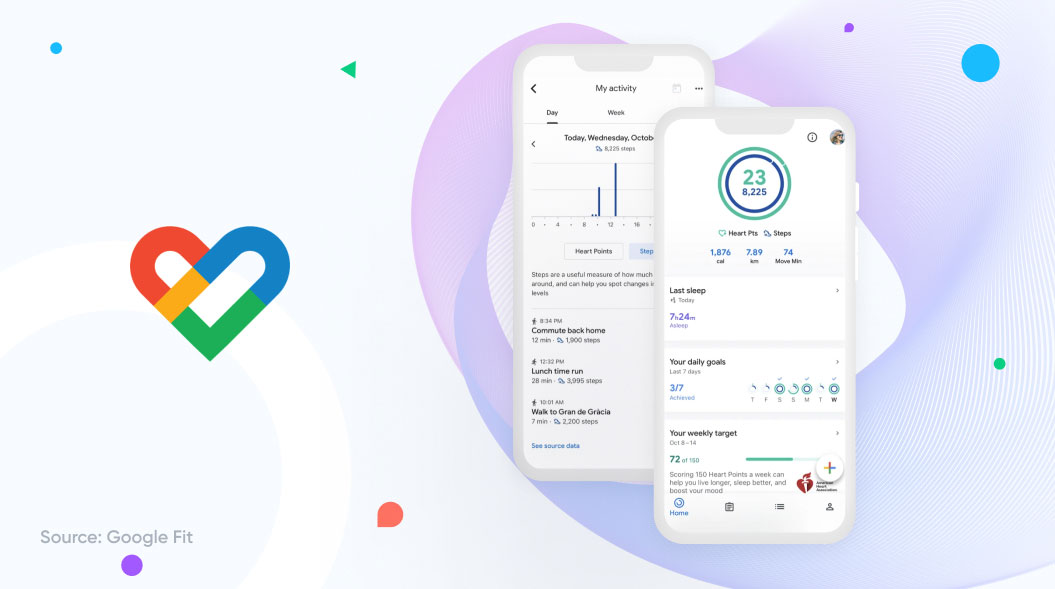
Google has done something amazing with Google Fit. While on its own it might seem like just another fitness app (good for tracking activities, logging workouts, etc.), what makes it special is that it integrates with a mindblowing number of apps and wearables.
Why does this matter? Essentially, Google Fit serves as a hub for all your other fitness apps and devices. For example, say you use MyFitnessPal to track your food, an Apple Watch to track your steps, and Jefit to track your weight training. Google Fit compiles all that data in one place, where you can review it. It can then provide customized advice based on your health and workout history. And yes, it’s available on iOS devices!
What made Google Fit Successful?
- Google collaborated with the World Health Organization (WHO) to provide great health coaching tips for its users
- Flawless integrations (with software and hardware) can make it a unified hub for anyone’s workout efforts
- As part of the Google ecosystem, users can connect to other Google products (like the Google Calendar) to create a better experience
Download: Android
6. 8Fit
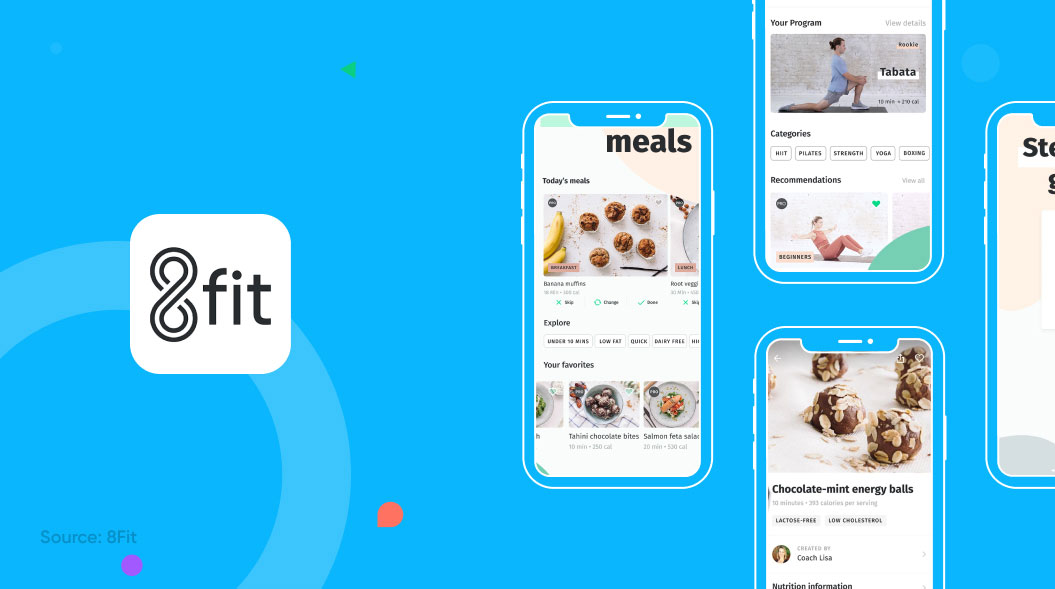
8Fit is a free fitness app that includes a subscription option, and its main focus is sustainable health. While it comes with plenty of workouts, it’s more about holistic health than getting big, buff, and shredded.
In that vein, 8Fit offers workouts you can do from home, recipes and meal plans you can personalize, and even pre-recorded guided meditations. It also features a wide library of articles in the following categories:
- Nutrition (e.g., meal plans, healthy eating)
- Fitness (e.g., home workouts, strength training, yoga)
- Lifestyle (e.g., sleep, self-care, pregnancy, parenting)
- Recipes (e.g., vegan, keto, easy meals, healthy desserts)
What made 8Fit Successful?
- A comprehensive focus on holistic wellness
- Vast article library
- Workouts to fit any lifestyle
7. Strava
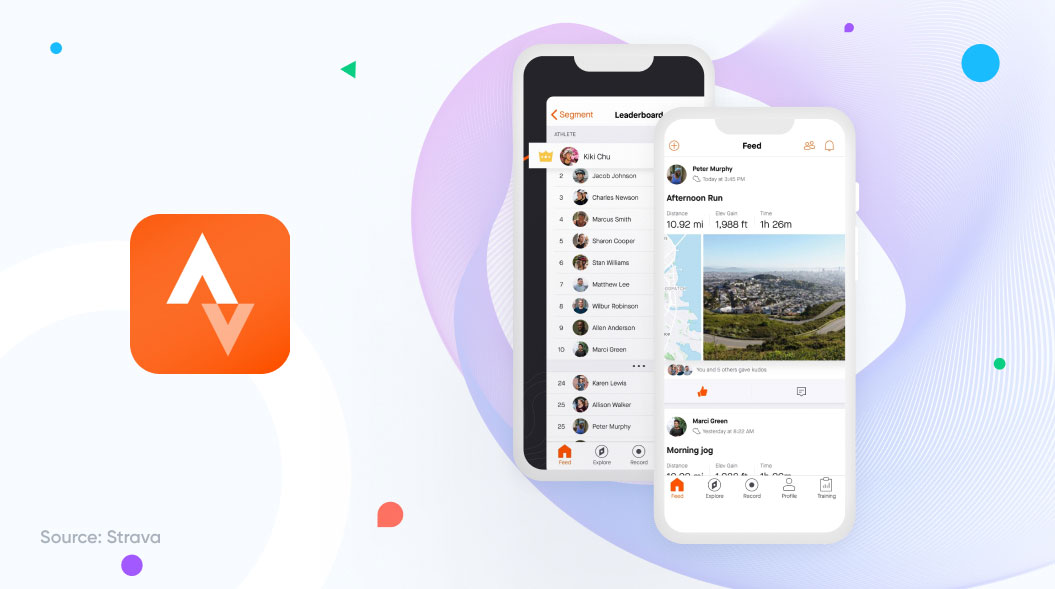
Strava is the go-to app for outdoor athletes who would rather run, bike, and walk than spend their time in a gym. That said, users can still target all their gym activities on Strava, including weight training, ellipticals, and exercise bikes. It’s just clear, when you visit their website, that in-door training is not the main focus of their brand. Instead, Strava’s website features athletic-looking men and women taking epic bike rides and long-distance runners.
Strava’s GPS tracker is highly accurate, and its calorie counter provides a reasonable estimate based on distance and speed. Athletes can use Strava to analyze their performance, track their workouts, and follow their friends’ workouts.
What made Strava successful?
- Special focus on outdoor athletic activities
- Amazing GPS tracker
- Comprehensive workout analytics
8. Nike Training Club
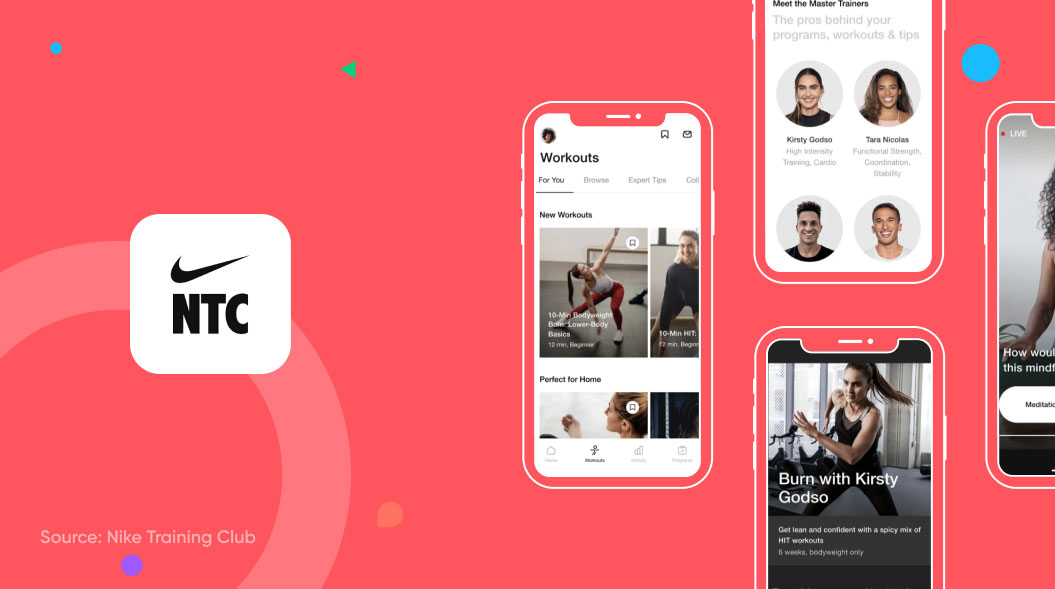
Full disclosure here—we’ve worked with Nike at Net Solutions in the past, helping to design and build the website to advertise London’s biggest half marathon.
That said, our past relationship with this sportswear giant had nothing to do with making our top 10 list. This just happens to be one of the best fitness tracker apps available. Thanks to its wide selection of workouts (yoga, HIIT, strength training, and much more), this free fitness app truly delivers.
Don’t take our word on it, though. The Nike Training Club app won the Editor’s Choice Award from Apple, and it currently has a 4.9 rating on the Apple store.
What made the Nike Training Club app stand out?
- Comprehensive selection of workouts
- Plenty of articles to help improve your health
- Free for all users (it used to cost money, but Nike made it free during the pandemic and plans to keep it that way)
9. HealthifyMe
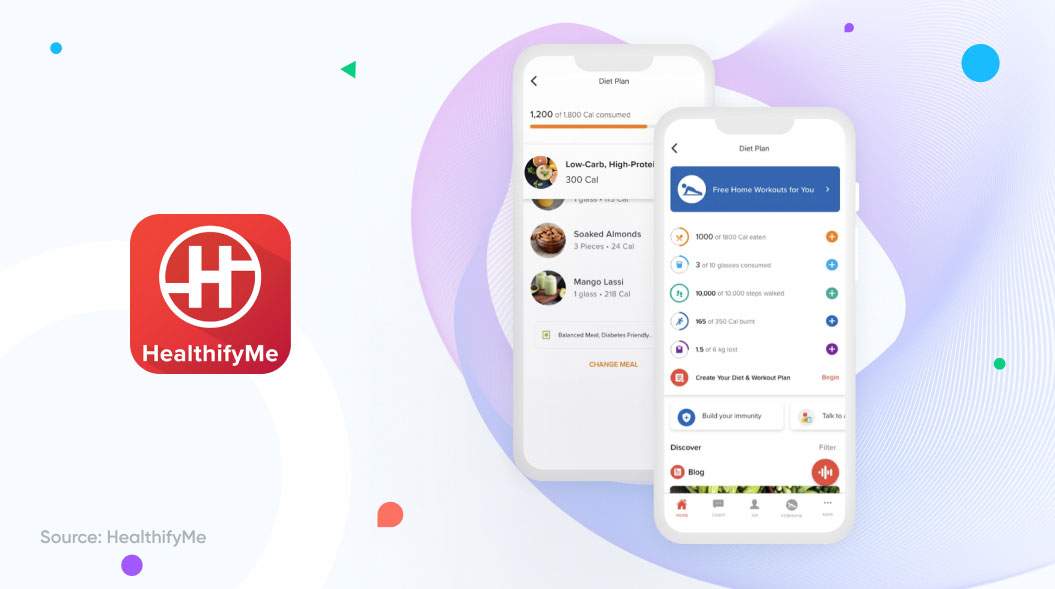
HealthifyMe took an interesting approach to compete with other fitness tracker apps. While there’s a do-it-yourself component that anyone can use, it also serves as a fitness coach app by giving users access to nutritionists and personal trainers. Anyone who can’t afford a nutritionist can use “Ria,” the app’s AI fitness coach. Ria can help users select the right meals and plan workouts that help them achieve their goals.
What made HealthifyMe stand out?
- Personal training and nutrition coaching along with do-it-yourself tools
- Tons of articles that cover a range of health- and fitness-related topics
- Highly usable product with excellent UX design elements
10. Cult.fit
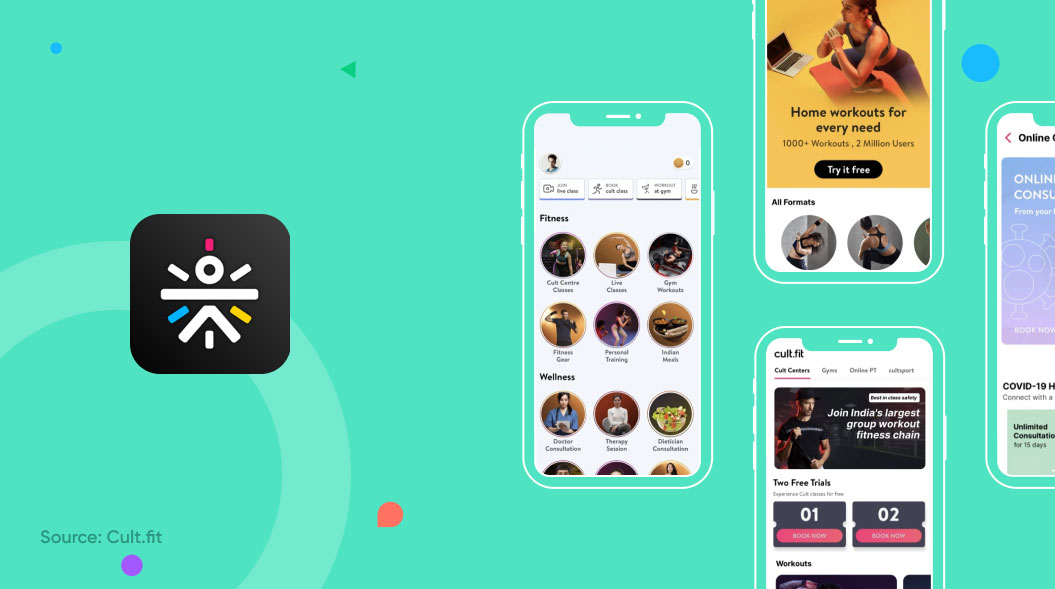
Cult.fit takes holistic health to the next level. It provides ways to track diet, exercise, and mindfulness training (like Yoga and meditation), but it doesn’t stop there.
Cult.fit subscribers can access medical doctors through the app for online consultations, and they have plenty of training opportunities through live classes and private sessions with trainers. Add to that a vast library of resources to learn about health at every level, Cult.fit provides a one-stop-shop for a healthy mind and body.
What made Cult.fit successful?
- A complete focus on all levels of health
- Access to medical doctors who offer online sessions
- Plenty of at-home workout classes to serve users in different time zones across the globe
Standing out in the Fitness App World
If you’re considering creating your fitness app and moving ahead in the mobile app development world, you’re entering a potentially lucrative market.
Just know that it’s also a crowded market, and in order to stand out, you have to offer something a little different.
That doesn’t mean your fitness app has to be radically different from everything else on the market. As you can see from the apps on this list, there’s plenty of overlap in features and sometimes even the niches they serve. Nevertheless, each app has its own brand identity, and each top fitness app does something special. That “something special” is what we refer to in software development as a product’s “killer app.” Every successful software product has a killer app that it’s known for.
Google Fitness’s killer app, for example, is serving as a hub to connect all your other fitness apps. Jefit’s killer app is its weight training animations and videos. Strava’s killer app is its GPS tracker.
Do you have an interesting fitness solution you want to introduce to the marketplace? You can focus on special features, specific workout niches (like High-Intensity Interval Training, or HIIT for short), or anything else that will give you an edge.
Once you’ve got an idea and are ready to move forward, talk to one of our specialists here at Net Solutions. We’ll give you an honest assessment of your project’s feasibility based on existing technology, your budget, and the features you hope to offer in your Minimum Viable Product(MVP). We have expertise in providing our clients with the best mobile app development services.
Jump on the bandwagon!

